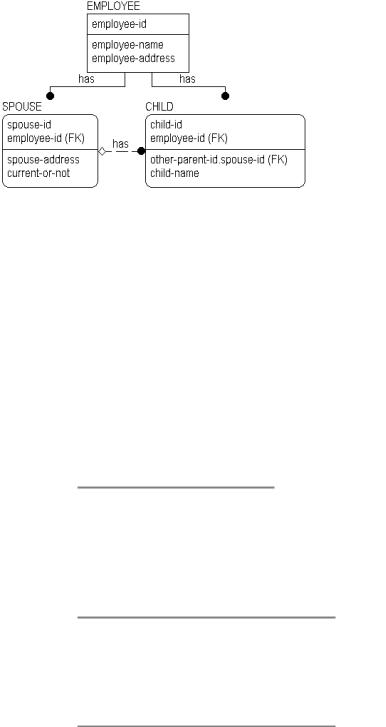
- •Contents
- •Preface
- •Intended Audience
- •About this Guide
- •Typographical Conventions
- •Related Documentation
- •What’s In This Chapter?
- •Chapter Contents
- •What is Data Modeling?
- •Data Modeling Sessions
- •Session Roles
- •Sample IDEF1X Modeling Methodology
- •Logical Models
- •The Entity Relationship Diagram
- •The Key-Based Model
- •The Fully-Attributed (FA) Model
- •Physical Models
- •The Transformation Model
- •The DBMS Model
- •Benefits of Modeling in ERwin
- •What’s In This Chapter?
- •Chapter Contents
- •The Entity-Relationship Diagram
- •Defining Entities and Attributes
- •Logical Relationships
- •Many-to-Many Relationships
- •Validating the Design of the Logical Model
- •Data Model Example
- •What’s In This Chapter?
- •Chapter Contents
- •Understanding Keys
- •Selecting a Primary Key
- •Designating Alternate Key Attributes
- •Inversion Entry Attributes
- •Relationships and Foreign Key Attributes
- •Dependent and Independent Entities
- •Identifying Relationships
- •Non-Identifying Relationships
- •Rolenames
- •What’s In This Chapter?
- •Chapter Contents
- •Naming Entities and Attributes
- •Synonyms, Homonyms and Aliases
- •Entity Definitions
- •Descriptions
- •Business Examples
- •Comments
- •Definition References and Circularity
- •Constructing a Business Glossary
- •Attribute Definitions
- •Rolenames
- •Definitions and Business Rules
- •What’s In This Chapter?
- •Chapter Contents
- •Relationship Cardinality
- •Cardinality in Non-Identifying Relationships
- •Referential Integrity
- •Reading Referential Integrity Options
- •RI, Cardinality, and Identifying Relationships
- •RI, Cardinality, and Non-Identifying Relationships
- •Additional Relationship Types
- •Many-to-Many Relationships
- •N-ary Relationships
- •Recursive Relationships
- •Subtype Relationships
- •Complete Versus Incomplete Subtype Structures
- •Inclusive and Exclusive Relationships
- •IDEF1X and IE Subtype Notation
- •When to Create a Subtype Relationship
- •Introduction
- •Chapter Contents
- •Overview of the Normal Forms
- •Functional Dependence (FD)
- •Full Functional Dependence
- •First Normal Form (1NF)
- •Second Normal Form (2NF)
- •Third Normal Form (3NF)
- •Common Design Problems
- •Repeating Data Groups
- •Multiple Use of the Same Attribute
- •Multiple Occurrences of the Same Fact
- •Conflicting Facts
- •Derived Attributes
- •Missing Information
- •Unification
- •How Much Normalization Is Enough?
- •Conclusions
- •ERwin Support for Normalization
- •First Normal Form Support
- •Second and Third Normal Form Support
- •What’s In This Chapter?
- •Chapter Contents
- •Creating a Physical Model
- •Denormalization
- •Classification of Dependent Entities
- •Glossary of Terms
- •Index
- •Documentation Comments Form

ERwin Methods Guide |
6 |
|
|
Derived Attributes
Another example of conflicting facts occurs when third normal form is violated. For example, if you included both a “birth-date” and an “age” attribute as non-key attributes in the CHILD entity, you violate third normal form. This is because “age” is functionally dependent on “birth-date.” By knowing “birth-date” and the date today, we can derive the “age” of the CHILD.
Derived attributes are those that may be computed from other attributes (e.g., totals) and therefore need not be stored directly. To be accurate, derived attributes need to be updated every time their derivation source(s) is updated. This creates a large overhead in an application that does batch loads or updates, for example, and puts the responsibility on application designers and coders to ensure that the updates to derived facts are performed.
A goal of normalization is to ensure that there is only one way to know each fact recorded in the database. If we know the value of a derived attribute, and we know the algorithm by which it is derived and the values of the attributes used by the algorithm, then there are two ways to know the fact (look at the value of the derived attribute, or derive it from scratch). If you can get an answer two different ways, it is possible that the two answers will be different.
For example, we can choose to record both the “birth-date” and the “age” for CHILD. And suppose that the “age” attribute is only changed in the database during an end of month maintenance job. Then, when we ask the question, “How old is such and such CHILD?” we can directly access “age” and get an answer, or we can, at that point, subtract “birth-date” from “today’s-date.” If we did the subtraction, we would always get the right answer. If “age” has not been updated recently, it might give us the wrong answer, and there would always be the potential for conflicting answers.
There are situations, where it makes sense to record derived data in the model, particularly if the data is expensive to compute. It can also be very useful in discussing the model with the business. Although the theory of modeling says that you should never include derived data (and we urge you to do so only sparingly), break the rules when you must. But at least record the fact that the attribute is derived and state the derivation algorithm.
Normalization ∙ 81

6 |
ERwin Methods Guide |
|
|
Missing Information
Missing information in a model can sometimes result from efforts to normalize the data. In our example, adding the SPOUSE entity to the EMPLOYEE-CHILD model improves the design, but destroys the implicit relationship between the CHILD entity and the SPOUSE address. It is possible that the reason that “emp-spouse-address” was stored in the CHILD entity in the first place was to represent the address of the other parent of the child (which was assumed to be the spouse). If we need to know the other “parent” of each of the children, then we must add this information to the CHILD entity.
Replacing Missing Information Using a New Relationship
EMPLOYEE
emp-id emp-name |
emp-address |
|
E1 |
Tom |
Berkeley |
E2 |
Don |
Berkeley |
E3 |
Bob |
Princeton |
E4 |
Carol |
Berkeley |
|
|
|
CHILD
emp-id child-id |
child-name |
other-parent-id |
|
E1 |
C1 |
Jane |
— |
E2 |
C1 |
Tom |
S1 |
E2 |
C2 |
Dick |
S1 |
E2 |
C3 |
Donna |
S2 |
E4 |
C1 |
Lisa |
S1 |
Sample Instance Tables for EMPLOYEE, CHILD, and SPOUSE
82 ∙ Normalization

ERwin Methods Guide |
6 |
|
|
SPOUSE
emp-id spouse-id |
spouse-address |
current-or-not |
|
E2 |
S1 |
Berkeley |
Y |
E2 |
S2 |
Cleveland |
N |
E3 |
S1 |
Princeton |
Y |
E4 |
S1 |
New York |
Y |
E5 |
S1 |
Berkeley |
Y |
Sample Instance Tables for EMPLOYEE, CHILD, and SPOUSE
The normalization of this model is not completed, however. In order to complete it you must ensure that you can represent all possible relationships between employees and children, including those in which both parents are employees.
Normalization ∙ 83
